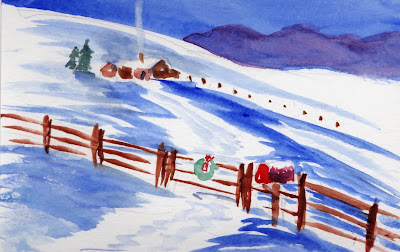 |
| Almost 10 years of blog traffic, note--started in May, 2009, not 2010 |
People in more than 150 countries have done so, and I've lost count.
Every year I've wondered about the future of this endeavor, probably more this year than ever as my life and focus have radically changed.
In fact, it marked the first time since it began in 2009 that I missed two months without writing.
My life, since retirement, has focused more on watercolor painting that writing--both are hard work but writing well takes much more time, for me, and while I'm still deep down a journalist, I'm more interested in becoming a visual storyteller.
It's reflected in how the blog has changed--once heavy on writing, then photography, it's now more a forum for my art work, combined with words.
This coming year may see the end of the blog as I try to merge it with a art website, but I'm technologically challenged. We'll see--but I need a better place to promote and sell what I do. I think.
But every year I recap what has be on the blog, so here goes. The question has always been, why do I bother, especially on something that makes no money? Journalism drives me, I guess.
Traffic, posting facts--
- 275,000+ page views since 2009.
- Highest monthly traffic--May, 2014--7,896 (May have been hacked by Russians--serious)
- Lowest monthly traffic--May, 2018--638
- 2,077 posts since 2009--all but one or two by me
- Most posts in a month--August, 2009--76
- Fewest posts in a month--April, May, 2018--0
- 2018 --149 (counting this one)
- 2017--158
- 2016--137
- 2015--136
- 2014--276
- 2013--252
- 2012--203
- 2011--134
- 2010--292
- 2009--339 (started in May)
- Totals--2007 posts in 2,948 days
Post with most traffic--"All aboard for Bartlesville," May, 2010
My most popular posts all seem to refer to trains. "All Aboard" may be click bait.Audience facts--
New countries with audience I know of this year--Yemen, Morocco, Turkmenistan, Zimbabwe, plus some from "Unknown region," in the EU.
This doesn't include all from the flag counter on my blog which I started using only a few years ago. I don't check the blog everyday, and therefore miss some, I guess.
North Korea? Checking the Flag counter showed me that visit sometime this year.
Below are the countries by continent that I had record of. (ignore the x'es, I was trying to keep up and write about them).
Then below are the multitude of ones on Flag Counter I didn't have.
Four notes.
- First, some of them are not independent territories, but still have individual flags, which is the Flag Counter.
- In addition, some are countries, that I missed.
- Third, I'm pretty good at geography, but there are places here I can't locate off the top of my head, and some I've not heard of. There's work to do in 2019, for a while at least.
- There are only about 168 countries in the world, so the flag counter adds territories, etc. I wonder about people who find this blog, what they think, how they find it, why so many in Russia find it interesting, and m
Total Pageviews by Countries |
Africa--Morocco, Algeria, Libya, Egypt, Togo, Ghana, Ethiopia, Ghana, Uganda, Tanzania, Kenya, Nigeria, Tunisia, Gabon, South Africa, Mali, Mauritus, Mauritania, Cameroonx, Zambia, Mozambique, South Sudan, Senegal, Benin, Angola, Botswana, Zimbabwe--27
Asia--Russia, China, Taiwan, Cambodia, S Korea, Hong Kong, Malaysia, Singapore, India, Vietnam, Sri Lanka, Pakistan, Bangladesh, Thailand, Kazahkstan, Azerbaijan, Japan, Mongolia, Armenia, Georgia, Nepal, Uzbekistan, Macau, Kyrgyzstan, Laos, Burma (Myamar), Turkmenistan-27
Caribbean--Caymans, Sint Maartin, Trinidad and Tobago, Puerto Rico, Jamaica, Dominican Republic, The Bahamas, Anguilla, Netherlands Antilles, St. Kitts and Nevis, Bermuda-11
Central America--Panama, Guatemala, Belize, Costa Rica, El Salvador-5
Europe--UKx, Isle of Man, Francex, Spainx, Germanyx, Italyx, Switzerlandx, Monaco, Czech Republicx, Polandx, Croatia, Greecex, Macedonia, Netherlandsx, Icelandx, Norwayx, Swedenx, Denmarkx, Finlandx, Latviax, Lithuania, Estonia, Belarus, Ukrainex, Bosnia and Herzegovina, Hungary, Romania, Serbia, Austria, Sloveniax, Belgium, Irelandx, Bulgariax, Turkey, Portugal, Luxembourg, Slovakiax, Albania,Slovenia, Leichtenstein, Montenegro-42
Indian Ocean--Maldives, Seychelles-2
Mediterranean--Maltax, Cyprus,-2
MidEast--Israel, Jordan, Saudi Arabia, Iran, Iraq, UAE, Kuwait,Qatar, Bahrain, Palestine, Lebanon, Oman, Yemen-, Syria-14
North America--US, Canada, Mexico-3
Oceana--Australia, New Zealand, Philippines, Indonesia, Guam, New Caledonia, Fiji, Samoa-7
South America--Colombia, Peru, Chili, Uruguay, Argentina, Brazil, Venezuela, Ecuador, French Guiana, Guyana, Bolivia, Paraguay-12
Unknown Region-EU
Total -152 countries
Total -152 countries
Other traffic on Flag counter: Aland Islands, Andorra, Armenia, Bhutan, British Virgina Islands, British Indian Ocean Territory, Brunei, Burkina Faso, Burundi, Cabo Verde, Cote d'Ivoire, Curaco, Democratic Republic of the Congo, Djbouti, Dominica, Equatorial Guinea, Eritrea, Falkland Islands, Guernsey, Guadaloupe, Grenada, Greenland, Gilbraltar, Georgia, French Guiana, Guinea-Bissau, Guayana, Haiti, Lesotho, Madagascar, Malawi, Malaysia, Malta, Marshall Islands, Martinique, Mayotte, Micronesia, Mongolia, Montserrat, Namibia, Nauru, Nicaragua, Niger, Niue, Norfolk Island, North Korea, Northern Mariana Islands, Oman, Palau, Palestinian Territory, Papua New Guinea, Republic of the Congo, Reunion, Rwanda, Saint Barthelemy, Saint Helena, Saint Lucia, Saint Martin, Saint Pierre and Miquelon, Saint Vince and the Grenadines, San Marino, Sao Tome and Principle, Sierra Leone, Solomon Islands, Suriname, Sudan, Svalbard, Swaziland, Tajikistan, The Gambia, Timor-Leste, Tonga, Turks and Caicos Islands, Tuvalu, Vanuatu, Vatican City, Virgin Islands, Wallis and Futuna,
Total--I don't know yet.


















